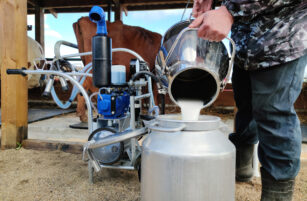Insight Focus
- November Milk Collection: NZ hits 239.2m kgMS; non-Fonterra share at 21.7%.
- Dry December expected to affect milk collections; NIWA warns of potential drought hotspots.
- Container freight market strengthens on Red Sea attacks.
New Zealand Milk Collections:
- Milk collection figures for November have been reported by all dairy processors. Our call of around 238 million kgMS (kilograms of milk solids) for New Zealand Milk Production was pretty close again, with the actual DCANZ (Dairy Companies Association of New Zealand) print for November coming in at 239.2 million kgMS.
- Fonterra do not print numbers from November until February so we cannot corroborate the market share development with complete certainty just yet. Based on our model for market share and the DCANZ November print we predict that the non-Fonterra share was 21.7% for November, which has Fonterra national collections at 187.3m kgMS and the non-Fonterra group above 51 million kgMS as expected.

- As we had expected, the drier weather conditions in November started to bite into milk collections. New Zealand collections are now up 0.72% Fonterra Financial Year to Date (even though Fonterra themselves are down about 0.5% through the same period).
- New Zealand weather in December was consistently dry in most key dairying regions.
- According to the National Institute of Water and Atmospheric Research (NIWA) “Regions experiencing significant soil moisture deficits are deemed “hotspots”. Persistent hotspot regions have the potential to develop into drought.” Prior to Christmas NIWA had identified three “hotspots” in the North Island and five in the South; importantly for dairy this list included one in interior Waikato.
- We have had some rainmakers hit the country over the New Year period and more are forecast at time of writing. This marks an interesting development as we stare directly at the extremely weather-sensitive “shoulder” of the New Zealand dairy production curve.
- After a significant period of drying out in much of December the soil moisture anomaly is now showing wetter than usual, especially in the Waikato which you can see is a lovely shade of blue below. We continue to monitor this closely along with the carry in the whole milk powder (WMP) futures curve which we expect might now start to be eroded.
- We are looking for a DCANZ print of just under 220 million kgMS for New Zealand Milk Production in December. Expectation would be up to 173 million kgMS from Fonterra. The non-Fonterra group should come in around 48 million kgMS for their second “best ever production for that month” in a row.

Source: NIWA
Market Intel:
- Demand for brands associated with, or perceived to be associated with, US companies in many Muslim-majority countries are being severely impacted due to public boycotts in push-back to the Israel-Gaza crisis. This is having an impact on dairy demand.
- NZ Butter sales are so strong that we can effectively remove the skimmed milk powder (SMP)/Butter stream from consideration in terms of product-mix decisions. Pundits should be following the SMP/AMF vs. WMP calculation to help determine which products marginal milk will be processed into.
- China is still not buying significant volumes on GDT.
- Freight:
- Due to the new attacks in the Red Sea most major carriers have changed their routings to the longer voyage around Africa.
- Many still believe that “the worst is yet to come”: There is some expectation that Asia will now also experience a container shortage during February to April.
- Carriers are trying to adjust freight rates on all routes, not just the ones via the Red Sea or Gulf region. This will increase CFR pricing for buyers globally.
- Asia to Europe routings are up approximately 150%.
- Asia to US routings are up approximately 35% for both US coasts.
- We have heard of a fire at a warehouse that was holding milk powder stock for ONIL (The Algerian Government buying entity). Depending on whether significant stock was lost directly in the fire or tainted by smoke this could potentially be impactful to the market.














